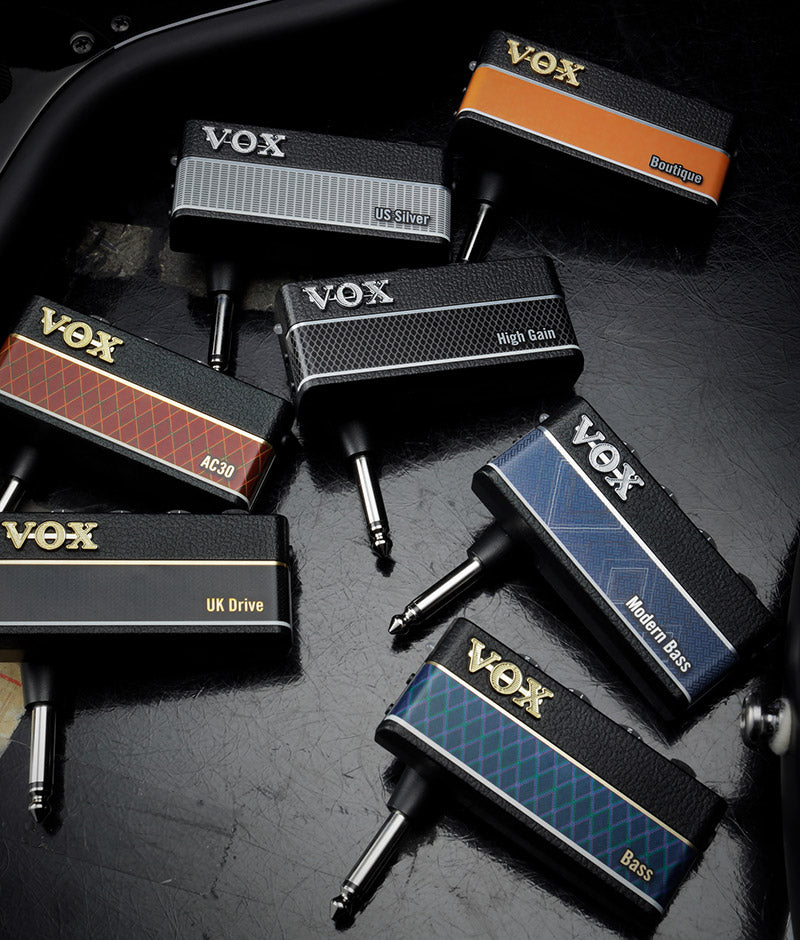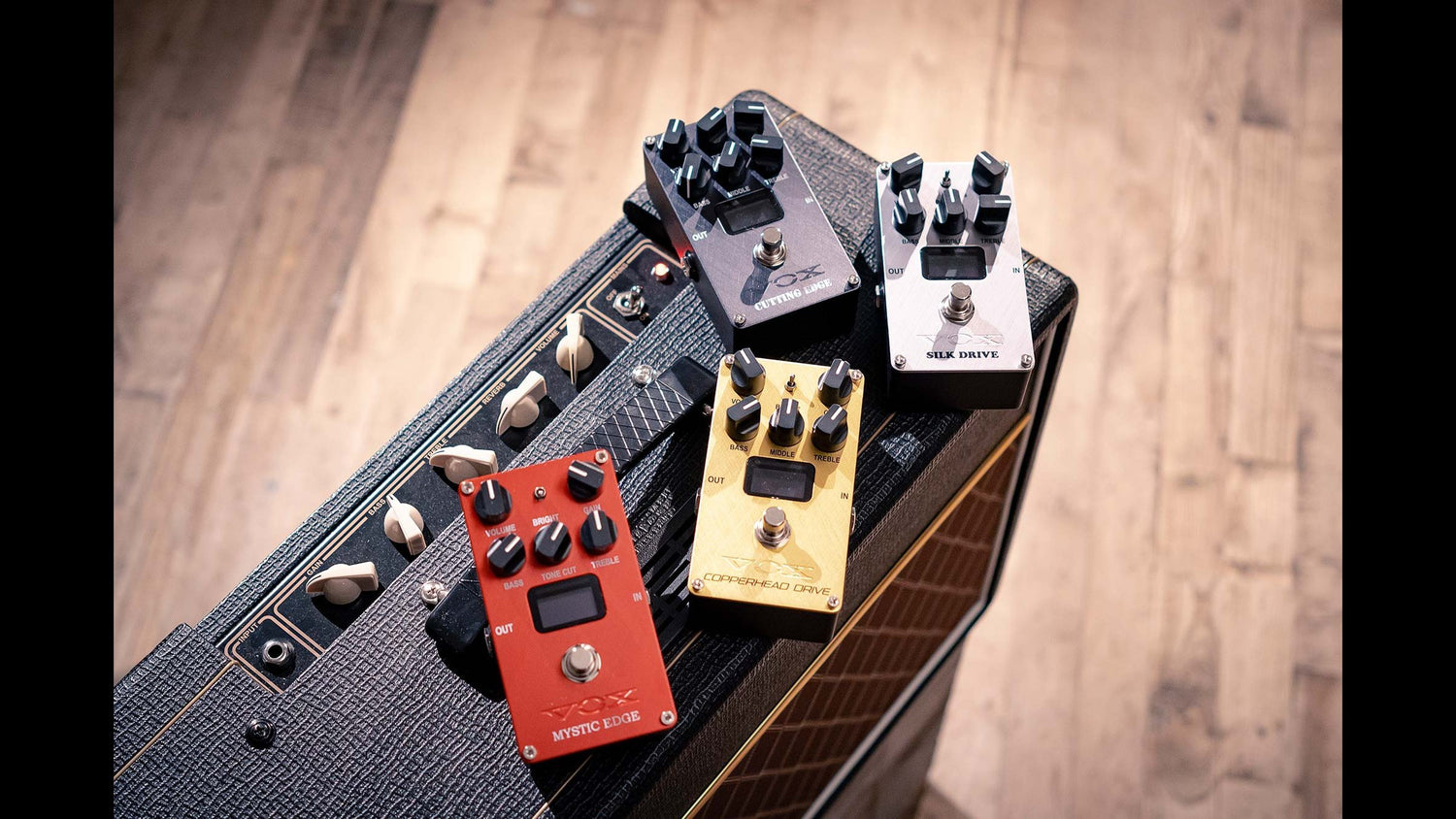Vox Valvenergy pedals are a range of valve distortion pedals using Nutube (a miniature, low-voltage vacuum tube) at the heart of the circuit to create the same response and feel and tone of some legendary styles of valve amplifiers - in a pedal!
The Valvenergy range is made up of the Silk Drive (VE-SD), Mystic Edge (VE-ME), Cutting Edge (VE-CE), and Copperhead Drive (VE-CD).
We take some time to explore the four pedals in the range with Philip Scarffe from Vox Amps R&D.
What were the design goals?
"The main design goals for the Valvenergy pedals were that we wanted to create a great sounding range of Nutube distortion pedals, but with extra features and some new technology thrown in to expand what the potential for a typical distortion pedal could be.
We also wanted to make the pedals more useful in different applications for the modern players, whether that is recording at home or live, amplifier-free performance. The modern guitar player is using technology in lots of different ways, so we wanted to make sure that we could take the typical design of a distortion pedal and add something new to it, so that it really expands the horizons for what the pedal could actually be used for."

Are Valvenergy pedals analogue or digital?
"The Valvenergy pedals are an interesting combination of different types of technology: it’s an all analogue signal path with a combination of solid state and Nutube valve gain stages - but then we also have a CPU inside of the pedals which is taking care of some clever switching and controls the OLED oscilloscope etc. So, whilst we’re using the digital technology to really help benefit the product and control some interesting things inside of the pedal, we’re actually trying to maintain the integrity of the analogue signal-path and the tone that comes from the Nutube itself."
How does the Nutube benefit the pedals?
"The Nutube is a massive breakthrough in vacuum tube technology. It's a miniature, low-power valve, operating just as any other typical vacuum tube would with an anode, a cathode and a grid, but because it requires lower voltages and less power consumption it means that it is perfect to integrate into a pedal design. Not only is the size of the tube itself a lot smaller than a typical 12X7 but it also means that it draws less current, meaning we can operate with a smaller supply and even run the tube from a typical 9-volt battery!
The real benefit of having the Nutube inside the circuit is not just that it adds the same harmonic distortion characteristics that you want from a vacuum tube, but it adds the dynamic, responsive feel that you get from a valve amp. The more you dig in the more it’s going to break up and compress, and then the lighter you drive the Nutube the less saturated it will become. It's very responsive and dynamic and it feels like you’re playing through an actual valve amp rather than just a pedal."

What is the oscilloscope?
"The oscilloscope is a really cool miniature OLED display that can show you the frequency and amplitude of the guitar signal coming out of the pedal. Depending on what you’re playing and how the pedal is set, and of course which pedal in the range you’re using, you’re going to be able to see the effect on the waveform that the pedal is having. If you increase the gain on the pedal you’re actually going to see the amount of extra saturation that’s coming and the effect that it has on the waveform. If you play harder you’re going to not only hear the difference but you can also see the difference that you’re playing and whatever else is in your signal chain is having on the shape of the waveform in real time."

What does the LINK feature do?
"The LINK jack is a really cool feature that allows you to connect multiple Valvenergy pedals together. When they are connected, the CPUs inside of each pedal can communicate with each other to configure the setup and operate in the same way that a multi-channel amplifier would. So, instead of selecting channel A or channel B on a multi channel amp, you can switch between any of the 4 Valvenergy pedals with just one hit of the foot-switch rather than multiple on and off on each pedal."
What are the three connection modes?
"We have an output select switch on the back of the pedals, which is there to allow the user to connect the pedals to different types of equipment. So the standard mode is the typical distortion pedal configuration, whereby you usually run that into the front end of a guitar amplifier.
We then have the cab sim mode which is a built in analogue cab sim, so that you can connect directly to a mixing desk or audio interface and have great sounding, recordable guitar tones.
The third pre-amp mode is a completely raw, direct, pre-amp signal coming form the pedal, which you can then combine with either a power amp, putting it into the effects loop return of an amplifier you have, or even recording that and then combining that sound with impulse responses of your choice, or any other way that you would like to process that raw pre-amp sound.
The output select helps when using the pedal in different applications and situations, and when combining it with different types of equipment."

How did you go about refining the tone and getting the pedals sounding just right?
"It’s very much a big international team development process at the end of the day. We’ve got lots of great ears, lots of great players, lots of great engineers that come together to sit in a room and bring in a ton of vintage amps and great sounding modern amplifiers.
Since these pedals are going to be used in different situations it’s important that we spent time checking these pedals in different applications. So running them through PA’s as much as we were doing it through different valve amplifiers and mixing desks and making sure that these pedals were reflective of different styles of valve amplifiers that we were trying to recreate."
Explore the Valvenergy pedal range further, find a dealer, or buy direct here.

